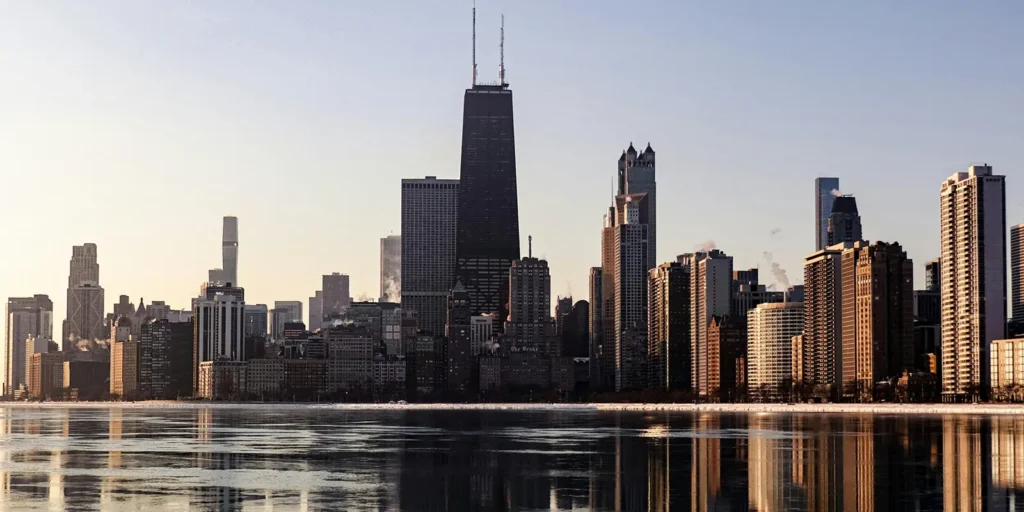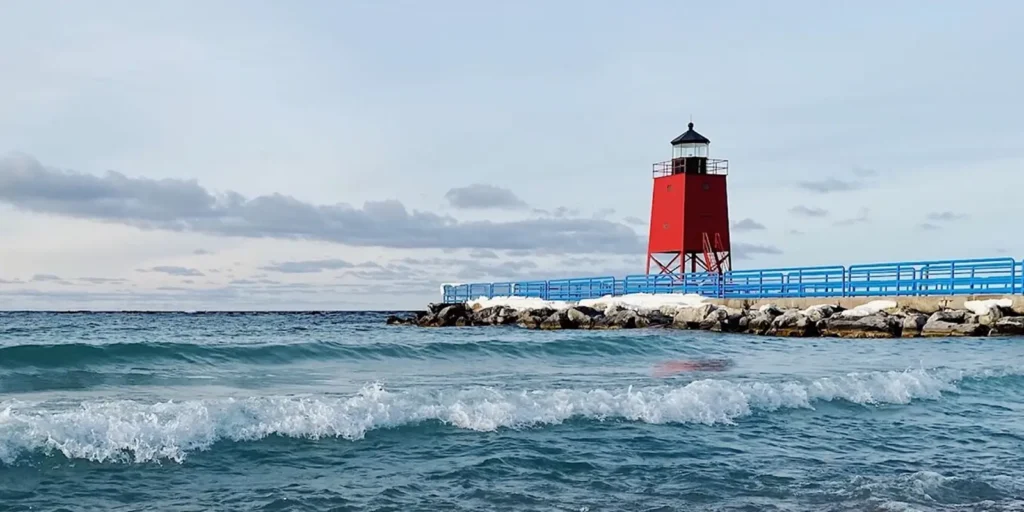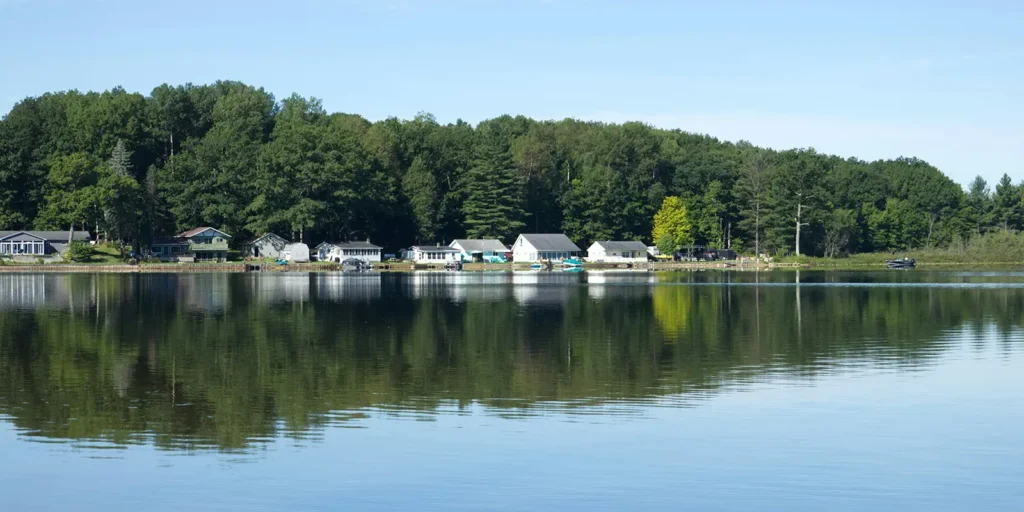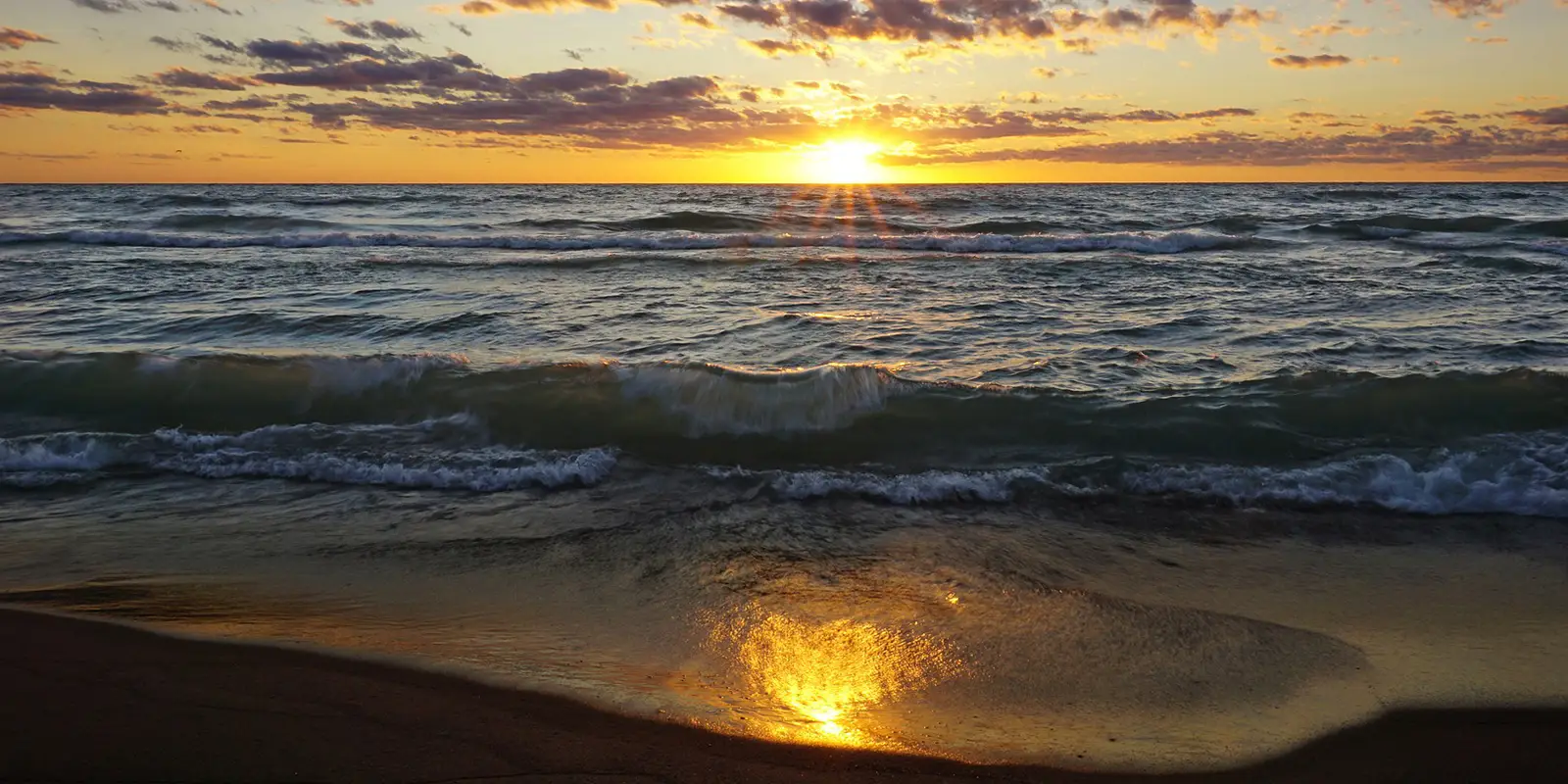Lake Michigan is the largest lake in the world wholly inside one country and its shores touch four states, Illinois, Indiana, Michigan, and Wisconsin. The name Michigan stems from the Ojibwa Indian word “mishigami”, which means “great water.” The U.S. shares the other four Great Lakes with Canada.
The Straits of Mackinac, a 4 to 5-mile-wide channel, connects Lake Michigan to Lake Superior. Storms quickly whip up winds that create high waves. Rocky shoals and shallows trap ships populating these straits. This channel is dangerous for ships to navigate. Divers and salvagers have yet to find all the ships beneath the strait’s and Great Lake’s waters.
What Makes Lake Michigan so Special?
Lake Michigan is the longest, from north to south, Great Lake. This is significant because its length creates diverse natural landscapes of hardwood and pine forests, tallgrass prairies, and wide savannas, plus the world’s largest freshwater sand dunes.
Lake Michigan is so special because of the wide range of water sports and fishing adventures available among incredible scenery. Lake Michigan sparked unique cultures in the towns and communities on its shores. There are hundreds of festivals and iconic tourist attractions around the lake, providing so much to see and do on and offshore.
Lake Michigan’s broad range of habitats fosters a huge collection of animals, birds, marine life, trees, and vegetation. Over 110 commercial ports, from small to large, connect via the Great Lakes-St Lawrence navigation system in Canada and the United States.
The U.S. Port Authority operates four ports on Lake Michigan. The Great Lakes operate some of the world’s largest grain shipping ports. Ocean ships and 1,000-foot lake boats ply Lake Michigan, et al. All types of commercial vessels operate on the Great Lakes, including Lake Michigan.
The information above is only the tip of the iceberg of Lake Michigan’s specialness. Numerous conservation agencies work to preserve its ecosystem. Hardcore surfers even take to Lake Michigan’s waves, which only stir up in fall, winter, and early spring, when the water is fffreeezzzinggg!

What Are 5 Interesting Facts About Lake Michigan?
1. The Straits of Mackinac Shipwreck Preserve Association provides buoys over its major dive sites in Lake Michigan. This association lists 28 shipwreck dive sights. Most of the ships on this list went under in the mid- to late 1800s and early 1900s, but two ships there sunk in 1965.
2. The Straits of Mackinac technically deem Lake Michigan and Lake Superior one great big Great Lake.
3. Lake Michigan boasts the largest accumulation of sand dunes on a freshwater coast on earth. NASA and the International Space Station have taken pictures of them from space. They are the largest freshwater sand dune system in the world. These dunes take up 275,000 acres.
4. The Michigan Triangle, which is compared to the Bermuda Triangle, has long presented unexplained phenomena like never-found ships and planes. The Michigan Triangle covers the area from the Ludington State Park Beach, Michigan, west across the lake to Manitowoc, Wisconsin, south to Benton Harbor, Wisconsin, and back northeast to Ludington.
5. Lake Michigan’s shoreline stretches for 1,638 miles. It has the longest freshwater shoreline of all U.S. lakes entirely within the U.S. borders.
There are many more Lake Michigan facts, but the list of them all is too long. This article attempts to bring attention to a few of the highlights that make Lake Michigan soar as a vacation destination for visitors and a beautiful place to live for locals.
What’s the Deepest Point in Lake Michigan?
The Lake Michigan depth varies according to distance from shore. The physical statistical data of the Great Lakes is quite phenomenal. Lake Michigan and the Great Lakes are known as inland seas because their water bodies behave like ocean waters.
The Lake Michigan deepest point is 925 feet. Lake Michigan’s average depth is 279 feet. It is 307-miles long and 118-miles wide with 1,638 miles of shoreline. Lake Michigan covers 14.34 million surface area acres. Its primary inflows are the Straits of Mackinac and seven rivers. Its primary outflows are the Straits of Mackinac and the Chicago River.

Is it OK to Swim in Lake Michigan?
Lake Michigan claims the title as the deadliest of the five Great Lakes. It is super important to know before you go to Lake Michigan—its weather conditions. Lake Michigan’s super strong rip currents have taken hundreds of lives. Knowing the wave conditions, weather and beach forecasts, and where to check for local beach forecasts are crucial.
Yes, it is OK to swim in Lake Michigan as long as you know the dangers. In 2002, rip currents claimed over 250 drowning victims at Lake Michigan. In June, its average water temperature is 45°. Lake Michigan’s warmest average water temps occur from July through September and range from the low 60s to the high 60s.
The U.S. Coast Guard’s (USCG) rescue teams stay on the go. The Great Lakes weather conditions bring on storm surges, strong rip currents, tsunamis, rogue waves, unique extreme weather phenomena, and destructive surf. The annual death toll at Lake Michigan is close to the total sum of the other four Great Lake’s death tolls .
A popular Google search is, “Is Lake Michigan salt water?” The answer is, No, Lake Michigan is a freshwater lake, not saltwater. The Great Lakes together are the largest freshwater system in the world. The Calumet, Chicago, Fox, Grand, Kalamazoo, Menominee, Muskegon, and St. Joseph Rivers flow into Lake Michigan.
Lake Michigan beaches range from white sand beaches to soft, sugar-sand beaches to pine-green, forested parklands, to its grandiose sand dunes. Lake Michigan hosts hundreds of beaches, from highly trafficked to privately secluded ones. Lake Michigan temperatures (air) range from warm humid summers to freezing cold winters with snow storms.
How Do I Spot a Rip Current?
Rip currents can occur near beaches under breaking waves and in any large water body that produces waves. The resemble river currents that cut through breaking waves and channel out to deeper waters. They are strongest and fastest nearest the water surface and pull swimmers with them at speeds of 8-feet per second for hundreds of yards.
Rip currents are born out of all that water coming toward the shore via waves that have to find a way back out. When you arrive at the beach, take five to ten minutes to assess surf conditions and identify where these areas are:
- The safest/calmest most area along a beach is usually a rip.
- A rip is usually the area devoid of wave activity and appears darker and deceptively calmer.
If you are caught in a rip current:
- Do not panic
- Realize what direction the rip is taking you to
- Swim to the right or left of the direction of flow with the flow’s direction, and swim out of the rip as soon as you can.
- Save your energy and float or tread water if you cannot swim out of the rip
- Rips will usually throw you out of their grip eventually
- If you are able, raise an arm as a distress signal
Has Anyone Swum Across Lake Michigan?
Only one person has been recorded as swimming the width of Lake Michigan. According to Jim “The Shark” Dreyer’s website, he started with beginner swimming lessons when he was 32-years-old. He wanted to overcome a fear of open after he almost drowned as a child.
Dreyer swam the width of Lake Michigan from the Rawley Point Lighthouse at Two Rivers, Wisconsin, to the Big Sable Point Lighthouse at Ludington, Michigan, in 1998, from August 1st to the 3rd. He also swam Lake Michigan’s length from September 8th to October 7th in 2003 from Michigan City, Indiana, to the Mackinac Bridge in the Straits of Mackinac.
Dreyer attempted a 2023 swim to beat his own record by swimming from Milwaukee to Grand Haven, where his route was 25-miles further than his 1998 record. Lake Michigan was misbehaving, and he had to abandon this attempt. Dreyer even swam a double crossing of the Straits of Mackinac, navigating the bustling shipping channel on his own and towing his supplies on a buoy.

Lake Michigan Fishing
The Michigan Sea Grant reports finding 68 species of fish in Lake Michigan and that 136 fish species appear in the Lake Michigan watershed. Michigan Sea Grant funds research, education, and outreach projects designed to foster science-based decisions about the use and conservation of Great Lakes resources.
Chinook salmon are “King Salmon” in Lake Michigan and most popular with Lake Michigan anglers. Other angler’s popular game species include smallmouth and largemouth bass, crappie, lake herring, muskellunge, yellow perch, northern pike, Atlantic and coho salmon, smelt, brown, lake, and steelhead trout, walleye, and white fish.
Lake Michigan remains a fantastic fishing destination. Lake Michigan is a vast lake with various habitats on rocky shorelines, sandy bottoms, and shallow bays, along with submerged vegetation and deepwater areas. The many regions of Lake Michigan support different fish species in different seasons.
In tandem, the Great Lake’s commercial, recreational, and tribal fisheries support over 75,000 jobs. Commercial fishing and recreational anglers harvest an estimated 65-million pounds of fish annually. The Great Lakes fisheries are collectively valued at over $7 billion yearly.
Lake Michigan interconnects with the other Great Lakes, which create a complete regional food web. Changes in one lake can have domino effects on the entire Great Lakes ecosystem. For about 200 years, invasive species, historic over fishing, dams on its tributaries, and habitat loss have affected the Great Lakes system.
Several mid-level forage fish that provided food for predatory fish have died off in The Great Lakes. They were the foundation of a healthy and productive marine food network. Today, federal, state, and tribal agencies collaborate to mitigate these losses.
The results have shown an improved water quality, that key invasive species populations have dropped, and restorative conditions are re-establishing native fish species. The Great Lakes, including Lake Michigan, provide habitats for one of the world’s best fisheries in the 21st century’s third decade.
The National Oceanic and Atmospheric Administration (NOAA) operates the Lakes Environmental Research Laboratory (GLERL). It employs remotely operated vehicles, deepwater probes called sondes, and repurposed marine watercraft to conduct year-round research for the University of Wisconsin-Milwaukee’s School of Freshwater Sciences.








1 Comment